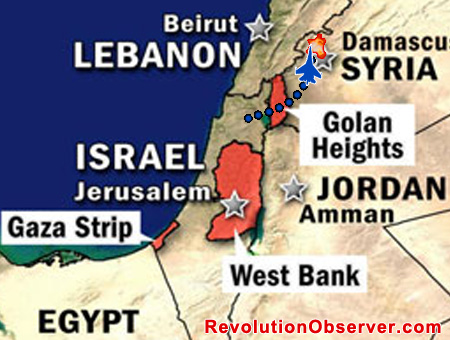By Adnan Khan
Details continue to emerge of Israeli air strikes on several targets in Syria on the border of Lebanon. Reuters initially reported the air strike, where four Israeli aircraft entered Lebanese airspace around 4:30 p.m. the evening of January 29 2013, remaining in Lebanese airspace until about 8 a.m. the following day. These jets were also relieved by another round of fresh jets. A number of targets around Jamraya, north-west of the capital, Damascus were attacked.
In a statement, the Lebanese Army said 12 Israeli planes had entered Lebanese airspace in three waves for an extended period of time – from 16:30 on Tuesday to 07:55 on Wednesday. The General command of the Syrian Army issued its own statement[1] saying low-flying Israeli jets had crossed into Syria over the Israeli-occupied Golan Heights and bombed a military research centre in the area of Jamraya, the Assad regime released pictures[2] showing the aftermath of the attack. US officials stated the target was a convoy carrying SA-17 surface-to-air missiles.[3] Israeli defence minister Ehud Barak confirmed the attack at a security conference in munich, Germany, on 2 February 2013: “It’s another proof that when we say something we mean it. We say that we don’t think that it should be allowable to bring advanced weapon systems into Lebanon, the Hezbollah from Syria, when [Syrian President Bashar al-] Assad falls.”[4]
Israel has been on the back foot ever since it was forced into a humiliating truce with Hamas in November 2012. With the region still in a state of flux, Israel’s national security and continued existence is dominating its politics. What is significant about these strikes is the duration Israeli jets spent on the operation. It was prolonged, which would indicate the Israeli jets were not looking to strike a specific fixed target as this would not have needed a prolonged mission. This operation was awaiting a window of opportunity.
The footage showing the aftermath of the Israeli attack shows a destroyed mobile carrier for an anti-aircraft missile battery, a convoy of abandoned cars and trucks and a half-burnt tank amongst a number of other vehicles. This would be the first time an external player has interfered directly in the uprising in Syria which has seen the rebels make significant ground against Bashar al-Assad’s forces since late 2012. It is unlikely the attack had anything to do with Syria’s chemical weapons program, which Israeli officials have often cited as a likely target. As many experts have stated, such an attack would have caused massive environmental damage and would be easily identifiable.[5]
A number of western intelligence officers confirmed with TIME that the strikes were conducted out of concern that advanced military equipment might fall into the hands of Islamist extremists fighting to topple the government of Syrian president Bashar Assad.[6] Reports also suggest that in addition to Israeli attacks on Syria, the US is interested in launching attacks of its own, and that it is planning to attack targets around the northern city of Aleppo if the rebels get too close to chemical weapons depots.[6]
Since November 2012 the rebel forces have made significant advances which includes forcing the closure of Damascus international airport. The Israeli attacks took place in the context where the Syrian uprising is fast approaching two years and with large swathes of Syria under rebel control. With western surrogates in the Syrian National Coalition failing to gain any traction over the rebel fighters on the ground it would appear this attack by Israel with full blessing from the US took place in the context of the advancing rebel fighters on Damascus. With al-Assad struggling to halt the rebel advance the targets that were attacked as well as the military equipment was likely to fall into rebel hands which would have significantly increased their capability. An Israeli analyst encapsulated the Wests dilemma: “analysts have suggested that the greatest danger was not the use of chemical weapons, but that advancing rebels might seize them.”[7] This recent event highlights the crumbling of the current regime and the growing strength and support of the rebel forces to which the West recognizes as a threat and is working against to maintain its interests and influence in the region.
Details continue to emerge of Israeli air strikes on several targets in Syria on the border of Lebanon. Reuters initially reported the air strike, where four Israeli aircraft entered Lebanese airspace around 4:30 p.m. the evening of January 29 2013, remaining in Lebanese airspace until about 8 a.m. the following day. These jets were also relieved by another round of fresh jets. A number of targets around Jamraya, north-west of the capital, Damascus were attacked.
In a statement, the Lebanese Army said 12 Israeli planes had entered Lebanese airspace in three waves for an extended period of time – from 16:30 on Tuesday to 07:55 on Wednesday. The General command of the Syrian Army issued its own statement[1] saying low-flying Israeli jets had crossed into Syria over the Israeli-occupied Golan Heights and bombed a military research centre in the area of Jamraya, the Assad regime released pictures[2] showing the aftermath of the attack. US officials stated the target was a convoy carrying SA-17 surface-to-air missiles.[3] Israeli defence minister Ehud Barak confirmed the attack at a security conference in munich, Germany, on 2 February 2013: “It’s another proof that when we say something we mean it. We say that we don’t think that it should be allowable to bring advanced weapon systems into Lebanon, the Hezbollah from Syria, when [Syrian President Bashar al-] Assad falls.”[4]
Israel has been on the back foot ever since it was forced into a humiliating truce with Hamas in November 2012. With the region still in a state of flux, Israel’s national security and continued existence is dominating its politics. What is significant about these strikes is the duration Israeli jets spent on the operation. It was prolonged, which would indicate the Israeli jets were not looking to strike a specific fixed target as this would not have needed a prolonged mission. This operation was awaiting a window of opportunity.
The footage showing the aftermath of the Israeli attack shows a destroyed mobile carrier for an anti-aircraft missile battery, a convoy of abandoned cars and trucks and a half-burnt tank amongst a number of other vehicles. This would be the first time an external player has interfered directly in the uprising in Syria which has seen the rebels make significant ground against Bashar al-Assad’s forces since late 2012. It is unlikely the attack had anything to do with Syria’s chemical weapons program, which Israeli officials have often cited as a likely target. As many experts have stated, such an attack would have caused massive environmental damage and would be easily identifiable.[5]
A number of western intelligence officers confirmed with TIME that the strikes were conducted out of concern that advanced military equipment might fall into the hands of Islamist extremists fighting to topple the government of Syrian president Bashar Assad.[6] Reports also suggest that in addition to Israeli attacks on Syria, the US is interested in launching attacks of its own, and that it is planning to attack targets around the northern city of Aleppo if the rebels get too close to chemical weapons depots.[6]
Since November 2012 the rebel forces have made significant advances which includes forcing the closure of Damascus international airport. The Israeli attacks took place in the context where the Syrian uprising is fast approaching two years and with large swathes of Syria under rebel control. With western surrogates in the Syrian National Coalition failing to gain any traction over the rebel fighters on the ground it would appear this attack by Israel with full blessing from the US took place in the context of the advancing rebel fighters on Damascus. With al-Assad struggling to halt the rebel advance the targets that were attacked as well as the military equipment was likely to fall into rebel hands which would have significantly increased their capability. An Israeli analyst encapsulated the Wests dilemma: “analysts have suggested that the greatest danger was not the use of chemical weapons, but that advancing rebels might seize them.”[7] This recent event highlights the crumbling of the current regime and the growing strength and support of the rebel forces to which the West recognizes as a threat and is working against to maintain its interests and influence in the region.
[1]http://sana.sy/eng/21/2013/01/31/464736.htm
[2]http://www.timesofisrael.com/syria-releases-video-showing-damage-from-israeli-attack/
[3]http://www.bbc.co.uk/news/world-middle-east-21281923
[4]http://www.jpost.com/Defense/Article.aspx?id=301877
[5]http://www.timesofisrael.com/israel-likely-didnt-target-chemical-weapons-expert-says/
[6]http://world.time.com/2013/02/01/the-fallout-from-the-air-raid-on-syria-why-israel-is-concerned/#ixzz2Jq4uW4DS
[7]http://www.thenational.ae/thenationalconversation/comment/as-rebels-make-inroads-their-friends-of-syria- are-nervous#ixzz2ErgzorFj





